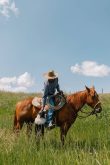When Sean LaBrie started his career with the Calgary Police Service, he likely didn’t realize that by the time he retired he’d be on a ranch an hour outside of the city, raising cattle on 640 acres. At that point in his life, cattle were barely more than a passing thought. Now, they’re his way of life.
“I would have never had this opportunity in my other life in Calgary,” LaBrie says during a tour of his operation in June. “This is fantastic. Again, wouldn’t give up the police career for anything … but what a great way to retire.”
Read Also

The Canadian Cattle Association’s international advocacy efforts
Global ag policies affect Canadian food policy, so the Canadian Cattle Association participates in international and domestic forums
Difficulty Ranch
Although LaBrie was born and raised in Calgary, Alta., he found himself drawn to the lifestyle his partner at the time was rooted in— ranching. She came from a big ranching family in southern Alberta, and that was his first introduction to the career that would become his passion.
“I was looking for a new challenge,” he says. “I’d been a policeman for about 10 years. And I have always been interested in rural life. A considerable amount of my family were farmers. But farming didn’t seem to be the right thing for me.”

They proceeded to buy an overgrazed operation, which would become what is now known as Difficulty Ranch.
LaBrie says the name was easy to come up with while purchasing the ranch.
“It was a difficult acquisition purchase, hence the name Difficulty Ranch. As well as I was having a two-hour commute every day, which certainly added to the difficulty, as well as two young children that added to the difficulty.”
But for LaBrie, the challenge of adding ranching to his plate while working full-time was worth it. As a police officer, he found that working with cattle and on the land helped with the stressors of his other job.
“I found that that was a great way to de- stress and kind of make the world make sense again, after dealing with difficult situations at work,” he says. The long com- mute gave him time to learn about ranching through podcasts and plan what to do next on the ranch, he adds.
Now, after working for the police for 15 years, LaBrie is retired from police work and has most of the ranch debt paid off. The once-overgrazed land is almost unrecognizable after his work with regenerative practices.
Regenerative ranching
A charter bus rolls down the backroads near Didsbury, Alta., an hour north of Calgary, kicking up dirt on a hot and dry day at the end of June. The bus pulls down a lane with a sign hanging proudly at the end of it, reading “Difficulty Ranch.” It crosses over a Texas gate to where LaBrie waits for the group from the International Federation of Agricultural Journalists to disembark.
Looking at him, you wouldn’t think he spent 15 years working for the Calgary police — not with his worn jeans, cowboy boots or the white cowboy hat on his head. Hearing him speak emphatically about regenerative agriculture, it’s clear LaBrie’s heart lies in ranching.
“It truly is a passion of mine,” he says later in an interview. “Coming from a city guy who thought that pastures were supposed to look like golf greens and the creeks were meant to be walked in by cows to where I am today has been a monumental transformation for sure.”
LaBrie had no idea what regenerative ranching practices were when he started Difficulty Ranch. However, in his first year as a rancher he joined the Foothills Forage and Grazing Association, which was his introduction to regenerative practices. LaBrie would join the board, and eventually become the president of the grazing association.
That organization, as well as the management practices of his partner’s family, helped him learn more sustainable solutions to bring back the grass on his land.
“My partner’s family, they were a three-generation ranching family from Longview and I learned a ton from her family on how to manage grass and how to manage riparian (areas),” LaBrie says. “Her family, being from a little bit different ecosystem, had to worry more about rain and grass management. I like to think that I took a lead from how they manage their grass, to manage my grass that way now.”
Now, LaBrie rotationally grazes on his operation using 30 paddocks. He also swath grazes in the winter.
“I also practice some standing grazing of crops, which have allowed me to rest native grass, as well as tame grass, for longer periods of time.”
His dedication to grass is evident on the tour as well, as the journalists hike through the long grass to view the watershed on his property, listening to LaBrie talk all about his management practices and the importance of the river.

Protecting riparian areas
When it comes to sustainable practices on his ranch, LaBrie’s passion is focused on riparian areas.
“That’s kind of my forte,” he says. “I’ve really worked hard at making water quality better downstream. Cows don’t water in the riparian areas, there’s no fertilizer anywhere near creek edges.”
LaBrie works on management projects with both Cows and Fish and Alternative Land Use Services (ALUS) — specifically, in the riparian area of his land.
He says he has a benchmark area in the riparian section where no cattle can get in and no mowing is done — it’s left completely natural and wild.
LaBrie also uses solar-powered pumps to draw water from the creek.
“I have fencing down both sides of the creek for the whole mile and a quarter,” he says.
His riparian areas are taken out of normal rotation and put on a three- to five-year rotation, depending on how they grow.
“Once I get to probably five years, I think (the cattle) will go in there regardless because they will start to become overgrown.”
In addition to ALUS and Cows and Fish, LaBrie has also worked with Sarcee Fish and Game Association and MacDonald’s.
Sarcee Fish and Game Association is working with LaBrie to boost the duck population on his land by putting duck nests into the waterbeds.
However, LaBrie says it’s not just about ducks — it’s about increasing wildlife numbers on his land and minimizing pests they have naturally.
“When we brought in the duck and bat blinds and nesting, we’ve certainly seen a drop in flies, we’ve seen a drop in mosquitoes so now we’re having less pinkeye problem. When we first started, we seemed to have quite a bit of pinkeye, and I would say that we virtually have none anymore. And I guess I’d like to think that we’re just working better with pest management.”
LaBrie joined MacDonald’s verified sustainable beef pilot program in 2016, and is still part of the Verified Beef Production Plus (VBP+) program.

“I felt that this was a fantastic way to kind of marry to the power of McDonald’s marketing, along with the power of the story that ranchers can tell,” LaBrie says.
The verified beef pilot tracked thousands of cattle from “birth to burger” and ensured sustainable practices were used on participating ranches.
“Still, today, they’re involved with western ranchers as well as promoting it through the public.”
Urban-rural divide
With so much experience in the ranching world under his belt and his history in the city, LaBrie has a unique opportunity to shed light on how people in the agricultural industry can help bridge the rural and urban divide.
He thinks it’s a big question, without an easy answer. He just tries to make a difference where he can, with the people he knows from the city.
“I have certainly encouraged all of my city friends, policemen and guys that I played hockey with to come out and visit my place,” he says. “A lot of them come to brandings. And now they’re bringing their kids to brandings, where they’re learning about agriculture, and they don’t just hear the mainstream media’s idea as to what agriculture is doing to the environment.”
He says by having friends of his come to his operation, they can see how what he does changes based on the needs of his herd and his operation.
“Some of their kids are asking fantastic questions about, ‘Well, I heard on the radio that cows were killing the planet through their farts.’ And some of their questions are even better. Well, I can see that they’re learning.”
Next-gen
LaBrie isn’t ready to retire yet from Difficulty Ranch, but when he is, he hopes to see both of his children take over the operation.
“I’m hoping to not be the first generation and the last generation of ranchers at Difficulty Ranch. My kids are very involved in the environmental aspects, they ask lots of questions,” LaBrie says.
Since LaBrie started ranching all those years ago, sustainability has become a large part of the operation. Now, for his children, that’s also something that has grabbed their attention as the future successors of the ranch.
“I think my kids are very interested in the environmental aspects of it.”

















